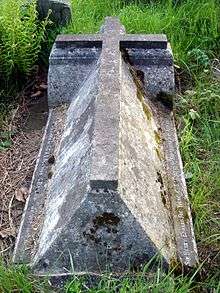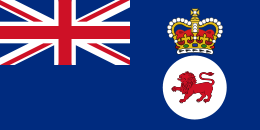Henry Young
| Sir Henry Young KCMG | |
|---|---|
 | |
| 5th Governor of South Australia | |
|
In office 4 August 1848 – 20 December 1854 | |
| Monarch | Queen Victoria |
| Preceded by | Frederick Robe |
| Succeeded by | Richard Graves MacDonnell |
| 1st Governor of Tasmania | |
|
In office 8 January 1855 – 10 December 1861 | |
| Monarch | Queen Victoria |
| Succeeded by | Thomas Gore Browne |
| Personal details | |
| Born |
23 April 1803 Brabourne, Kent, England, UK |
| Died |
18 September 1870 (aged 67) London, England, UK |
| Nationality |
|
| Spouse(s) | Augusta Sophia Marryat |
| Alma mater | Inner Temple |
Sir Henry Edward Fox Young, KCMG (23 April 1803 – 18 September 1870) was the fifth Governor of South Australia, serving in that role from 2 August 1848 until 20 December 1854. He was then the first Governor of Tasmania, from 1855 until 1861.[1]
Early life
Young was the third son of Sir Aretas William Young, a well-known peninsular officer, and was born at Brabourne, Kent.[1] He was educated at Dean's School, Bromley, Middlesex, and, intended for the bar, entered as a student at the Inner Temple.
Early career
Young was, however, appointed in 1827 to a position in the colonial treasury, Trinidad, and in 1828 was transferred to Demerara, British Guiana. In 1834 he became treasurer, secretary and member of the council at St Lucia, but from 1835 he was again in British Guiana as government secretary, and did important work over a period of several years during which occurred the emancipation of the Negro slaves. He was in London in 1847 and was appointed lieutenant-governor of the eastern district of the Cape of Good Hope.[2]
Governor of South Australia
Young was transferred a few months later to South Australia where he arrived on 1 August 1848 on the Forfarshire.[1] It was hoped that he would be able to announce some measure of responsible government but he had nothing to say on this subject, and it was not until February 1851 that an ordinance was passed constituting a Legislative council of 24 members, of whom eight were nominated by the crown (four officials and four appointed by the governor) and 16 were to be elected. Under Young, South Australia received its first formal parliament.
The South Australian House of Assembly comprised 36 members each elected from a different area. It was Governor Young who offered a prize of £2000 in 1851 for the first person to travel up the Murray River to its junction with the Darling River (now the town of Wentworth) in a paddle steamer. The prize was claimed in 1853 by Francis Cadell with his steamer Lady Augusta (named for Sir Henry's wife). Due to the difficulty of navigating the Murray Mouth, Young supported building the railway from the river port of Goolwa to the new sea port at Port Elliot (named after his friend, Charles Elliot). Young was president of the Adelaide Philosophical Society 1853–1854.[3]
Governor of Van Diemens Land/Tasmania
Young began his duties in Van Diemens Land in January 1855. Sir Henry Fox Young's term as Governor of Van Diemens Land was significant, because in 1856 the Island colony received self-government, and was renamed Tasmania to mark the fact and as a deliberate measure by free-settlers to distance its convict past. Sir Henry was the first Tasmanian Governor to occupy Government House, Hobart, the beautiful neo-gothic Vice-Regal residence on the banks of the River Derwent.
At this time the constitution act was awaiting the royal assent, and the legislative council might wisely have postponed meeting until news of this had been received. It, however, met in July and one of its acts was to form a committee to inquire into the working of the convict department. Dr Hampton, the comptroller-general of convicts, was summoned to appear as a witness and refused to attend. The council decided he was guilty of contempt and arrested him. Hampton served a writ of habeas corpus upon the sergeant-at-arms and the opinion of the law officers of the crown was against the legality of the council's proceedings. Young then attended at the house and prorogued the council until 20 October. The Times severely commented upon Young's conduct, but he was commended by the British government. The Tasmanian supreme court ruled against the council, and when it was taken to the privy council this decision was confirmed. The new constitution was soon successfully instituted and Young welcomed the change in his position, feeling that he was now above the battle and freed from much trying responsibility. He travelled through the island, showed much interest in its development, and capably carried out the work of his office.

Later life
Young left Tasmania on 10 December 1861 for Melbourne whence he travelled to England and lived in retirement at London until his death there on 18 September 1870. He married in 1848 the eldest daughter of Charles Marryat who survived him. He was knighted in 1847.
He is buried in Brompton Cemetery, London.
The town of Port Augusta in South Australia is named after Henry's wife, Lady (Augusta) Young.
References
- 1 2 3 H. J. Gibbney (1976). "Young, Sir Henry Edward Fox (1803 - 1870)". Australian Dictionary of Biography, Volume 6. MUP. pp. 452–453. Retrieved 2007-08-17.
- ↑ C. A. Harris, Young, Sir Henry Edward Fox (1808–1870), rev. Lynn Milne, Oxford Dictionary of National Biography, Oxford University Press, 2004; online edition, May 2006. The first edition of this text is available as an article on Wikisource:
 "Young, Henry Edward Fox". Dictionary of National Biography. London: Smith, Elder & Co. 1885–1900.
"Young, Henry Edward Fox". Dictionary of National Biography. London: Smith, Elder & Co. 1885–1900. - ↑ History of the Royal Society of South Australia
- Serle, Percival (1949). "Young, Henry Edward Fox". Dictionary of Australian Biography. Sydney: Angus and Robertson.
| Government offices | ||
|---|---|---|
| Preceded by Lieutenant Colonel Frederick Holt Robe |
Governor of South Australia 1848–1854 |
Succeeded by Sir Richard G. MacDonnell, CB |
| Preceded by Sir William Denison (Lieutenant-Governor of Van Diemen's Land) |
Governor of Tasmania 1855–1861 |
Succeeded by Colonel Thomas Browne |



